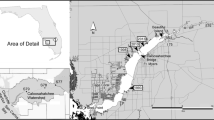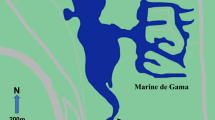Abstract
Ammophila arenaria, an invasive European beach grass, dominates most United States Pacific coast beaches north of San Francisco Bay, and it appears to severely reduce opportunities for regeneration of native plant species, including American beach grass,Leymus mollis. The knowledge of how longAmmophila rhizomes can survive in sea-water is important for long-tern management strategies, which must consider the probability of reinvasion of areas whereAmmophila has been eradicated. The bud viability of bothAmmophila arenaria andLeymus mollis remained high following submergence in sea-water for 7 days, andLeymus bud viability was still high after 13 days submergence. In fact,Leymus bud viability appears to be enhanced slightly by submergence for 7 days in sea-water. SinceAmmophila rhizomes retain a mean bud viability of >50% following submergence for 7 days, there is clearly the potential for long distance dispersal to other beaches. Even after 13 days of submergence,Ammophila rhizomes still had a mean bud viability of 8.5%. Assuming near-shore current speeds of 5–45 cm/sec, viableAmmophila rhizomes can be transported up to 505 km in 13 days.
Similar content being viewed by others
References
Anon. 1981.Ecological characterization of the central and northern California coastal region, Vol. 1. Basic ecological concepts. Fish and Wildlife Service, U.S. Department of the Interior FWS/OBS-80/45, Washington, DC.
Anon. 1988.Northern foredune grassland element stewardship abstract. Intern. rep. The Nature Conservancy, Arcata, CA.
Barbour, M.G. 1978. Salt spray as a microenvironmental factor in the distribution of beach plants at Point Reyes, California.Oecologia (Berl.) 32: 213–224.
Barbour, M.G. & Johnson, A.F. 1977. Beach and Dune, In: Barbour, M.G. & Major, J. (eds.)Terrestrial vegetation of California, pp. 223–262. John Wiley & Sons, New York, NY.
Barbour, M.G., De Jong, T.M. & Johnson, A.F. 1976. Synecology of beach vegetation along the Pacific Coast of the United States of America: a first approximation.J. Biogeogr. 3: 55–69.
Benecke, W. 1930. Zur Biologie der Strand- und DŸnenflora, 1. Vergleichende Versuche Ÿber die Salztoleranz vonAmmophila arenaria Link,Elymus arenarius L. undAgropyrum junceum L.Ber. Dtsch. Bot. Ges. 48: 127–139.
Bond, T.E.T. 1952. Biological flora of the British Isles:Elymus L.J. Ecol. 40: 217–227.
Boyd, R.S. 1992. The influence ofAmmophila arenaria on foredune plant microdistributions at Point Reyes National Seashore, CA.Madroño 39: 67–76.
Breckon, G.J. & Barbour, M.G. 1974. Review of North American Pacific Coast vegetation.Madroño 22: 333–360.
Buell, A.C., Pickart, A.J. & Stuart, J.D. 1995. Introduction history and invasion patterns ofAmmophila arenaria on the north coast of California.Conserv. Biol. 9: 1587–1593.
Chapman, V.J. 1976.Coastal vegetation. Pergamon Press, Oxford.
Cooper, W.S. 1958. Coastal sand dunes of Oregon and Washington.Geol. Soc. Am. Mem. 72: 1–169.
Cooper, W.S. 1967. Coastal sand dunes of California.Geol. Soc. Am. Memoir 104: 1–131.
Danin, A., Rae, S. Barbour, M., Jurjavcic, N., Connors, P. & Uhlinger, E. 1999. Early primary succession on dunes at Bodega Head, California.Madroño.
Doing, H. 1985. Coastal fore-dune zonation and succession in various parts of the world.Vegetatio 61: 65–75.
Gemmell, A.R., Greig-Smith, P. & Gimingham, C.H. 1953. A note on the behaviour ofAmmophila arenaria (L.) Link in relation to sand dune formation.Proc. Bot. Soc. Edinb. 36: 132–136.
Greig-Smith, P. 1961. Data on pattern within plant communities II.Ammophila arenaria (L.) Link.J. Ecol. 49: 703–708.
Greig-Smith, P., Gemmell, A.R. & Gimingham, C.H. 1947. Tussock formation inAmmophila arenaria (L.) Link.New Phytol. 46: 262–268.
Harris, D. & Davy, A.J. 1986a. Strandline colonization byElymus farctus in relation to sand mobility and rabbit grazing.J. Ecol. 74: 1045–1056.
Harris, D. & Davy, A.J. 1986b. Regenerative potential ofElymus farctus from rhizome fragments and seed.J. Ecol. 74: 1057–1067.
Hertling, U.M. 1997.Ammophila arenaria (L.) Link (marram grass) in South Africa and its potential invasiveness. Ph. D. Dissertation, Rhodes University, Gahamstown.
Hewett, D.G. 1970. The colonization of sand dunes after stabilization with marram grass (Ammophila arenaria).J. Ecol. 58: 653–668.
Heyligers, P.C. 1985. The impact of introduced plants on foredune formation in south-eastern Australia.Proc. Ecol. Soc. Aust. 14: 23–41.
Hickman, J.C. (ed.) 1993.The Jepson Manual. University of California Press, Berkeley, CA.
Hobbs, R.J., Gimingham, C.H. & Band, W.T. 1983. The effects of planting technique on the growth ofAmmophila arenaria (L.) Link andLeymus arenarius (L.) Hochst.J. Appl. Ecol. 20: 659–672.
Hsu, J.C. 1996.Multiple comparisons. Chapman & Hall, London.
Hulten, E. & Fries, M. 1986.Atlas of northern European vascular plants north of the Tropic of Cancer. Koeltz Scientific Books, Kšnigstein.
Huiskes, A.H.L. 1977. The natural establishment ofAmmophila arenaria from seed.Oikos 29: 133–136.
Huiskes, A.H.L. 1979. Biological flora of the British Isles:Ammophila arenaria (L.) Link.J. Ecol. 67: 363–382.
Johnson, P.H. 1982. Naturalized plants in Southwest South Island, New Zealand.N. Z. J. Bot. 20: 131–142.
Largier, J.L., Magnell, B.A. & Winant, C.D. 1993. Subtidal circulation over the Northern California shelf.J. Geophys. Res. 98: 147–179.
Lentz, S.J. & Chapman, D.C. 1989. Seasonal differences in the current and temperature variability over the Northern California shelf during the coastal ocean dynamics experiment.J. Geophys. Res. 94: 571–592.
Lubke, R.A. & Hertling, U.M. 1995. IsAmmophila arenaria (marram grass) a threat to South African dunefields?J. Coastal Conserv. 1: 103–108.
Maser, C. & Sedell, J.R. 1994.From the forest to the sea: the ecology of wood in streams, rivers, estuaries, and oceans. St. Lucie Press, Delray Beach, FL.
McAdam, J.H. 1980. Uncontrolled grazing and vegetation removal in the Falkland Islands.Environ. Conserv. 7: 201–202.
Pavlik, B.M. 1983. Nutrient and productivity relations of the dune grassesAmmophila arenaria andElymus mollis. III. Spatial aspects of clonal expansion with reference to rhizome growth and the dispersal of buds.Bull. Torrey Bot. Club 110: 271–279.
Pickart, A. 1988. Dune restoration in California: a beginning.Restor. Manage. Notes 6(1): 8–12.
Pickart, A.J. & Sawyer, J.O. 1998.Ecology and restoration of northern California coastal dunes. California Native Plant Society. Sacramento, CA.
Pitts, W.D. & Barbour, M.G. 1979. The microdistribution and feeding preferences ofPeromyscus maniculatus in the stand at Point Reyes National Seashore, California.Am. Midl. Nat. 101: 38–48.
Ranwell, D. 1972.Ecology of salt marches and sand dunes. Chapman and Hall, London.
Rejm‡nek, M. 1999. Invasive plant species and invasible ecosystems. In: Sandlund, O.T., Schei, P.J. & Viken, •. (eds.)Invasive species and biodiversity management, pp. 79–102. Kluwer Academic, London.
Salisbury, E. 1952.Downs and dunes. G. Bell and Sons, London.
Slobodchikoff, C.N. & Doyden, J.T. 1977. Effects ofAmmophila arenaria on sand dune arthropod communities.Ecology 58: 1171–1175.
Sykes, M.T. & Wilson, J.B. 1989. The effect of salinity on the growth of some New Zealand sand dune species.Acta. Bot. Neerl. 38: 173–182.
Tsuriell, D.E. 1974. Sand dune stabilization in Israel.Intern. J. Biometeorol. 18: 89–93.
van der Laan D, van Tongeren, O.F.R., van der Putten, W.H. & Veenbaas, G. 1997. Vegetation development in coastal foredunes in relation to methods of establishing marram grass (Ammophila arenaria).J. Coastal Conserv. 3: 179–190.
van der Putten, W.H. 1990. Establishment ofAmmophila arenaria (marram grass) from culms, seeds, and rhizomes.J. Appl. Ecol. 27: 188–199.
van Hook, S.S. 1983.A study of European Beachgrass, Ammophila arenaria (L.) Link: Control methods and a management plan for the Lanphere-Christensen Dunes Preserve. Intern. rep. The Nature Conservancy, Arcata, CA.
WallŽn, B. 1980. Changes in structure and function ofAmmophila during primary succession.Oikos 34: 227–238.
Wiedemann, A.M. 1987.The ecology of European beach-grass (Ammophila arenaria (L.) Link): a review of the literature. Oregon Department of Fish and Wildlife, Nongame Wildlife Program. Technical report #87-1-01.
Wiedemann, A.M. & Pickart, A. 1996. TheAmmophila problem on the Northwest coast of North America.Landscape Urb. Plann. 34: 287–299.
Wiedemann, A.M., Dennis, J. & Smith, F.S. 1974.Plants of the Oregon coastal dunes. Oregon State University Bookstores, Corvallis, OR.
Author information
Authors and Affiliations
Rights and permissions
About this article
Cite this article
Rachel, A., Marcel, R. The effect of sea-water submergence on rhizome bud viability of the introducedAmmophila arenaria and the nativeLeymus mollis in California. J Coast Conserv 6, 107–111 (2000). https://doi.org/10.1007/BF02730474
Received:
Revised:
Accepted:
Issue Date:
DOI: https://doi.org/10.1007/BF02730474




